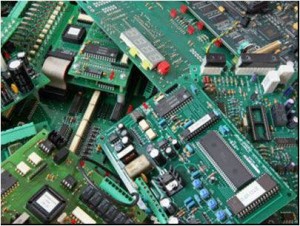India needs to focus on Electronics manufacturing sector as negligence of this sector will result in Electronic import bill getting higher than Oil import bill by 2020…
 Why we need EMS Industry in India? The questions seems to be very simple, and so are the answers, but not as casual as simple, Some of the facts are Nations like China, Singapore, Malaysia, Taiwan, Thailand etc. have built the success stories on the foundation of Electronics Hardware Industry. As software Industry can employ only white collar labour force, So we need a huge blue collar workforce which forms the backbone of the industrial landscape of India. In the background of fears of indiscriminate globalization of trade and commerce, there are genuine concerns of employment retention and well being of a large work force whose skill sets are valuable assets to the nation. India is not an island nation like Singapore, Taiwan or Mauritius where the entire work force can aspire to have only white collar jobs. As we have to grow our own agriculture, similarly we have to build our own Hardware products that are low cost and are designed for the Indian environment that cater to the needs of the Indian masses.
Why we need EMS Industry in India? The questions seems to be very simple, and so are the answers, but not as casual as simple, Some of the facts are Nations like China, Singapore, Malaysia, Taiwan, Thailand etc. have built the success stories on the foundation of Electronics Hardware Industry. As software Industry can employ only white collar labour force, So we need a huge blue collar workforce which forms the backbone of the industrial landscape of India. In the background of fears of indiscriminate globalization of trade and commerce, there are genuine concerns of employment retention and well being of a large work force whose skill sets are valuable assets to the nation. India is not an island nation like Singapore, Taiwan or Mauritius where the entire work force can aspire to have only white collar jobs. As we have to grow our own agriculture, similarly we have to build our own Hardware products that are low cost and are designed for the Indian environment that cater to the needs of the Indian masses.
With a predominantly young — and still growing, India needs to maintain solid growth over the next years to keep its citizens employed. Its economy, while expanding, is still in transition to a market system, and its per capita income remains amongst the lowest in the world. Like many developing nations, India has thousands of rich people living side by side with thousands of poverty-ridden communities. Transforming the technological economy would require the government to move beyond software businesses to include traditional hardware manufacturing. So, India wants semiconductor fabs as well as assembly plants.
Growth Prospective of Indian EMS Industry
India aims for $400B electronics manufacturing sector by 2020.
The government of India hopes the subsidy, which is capped at US$8.7 million (500 million rupees), will encourage the build of 200 Indian EMCs by 2020, according to Department of Electronics and Information technology. India is aiming for a US$400 billion electronics manufacturing industry by 2020, which means the industry must increase by more than five times over the next seven years. To achieve the stated goal, the government will subsidize 50 percent of the cost of building electronics manufacturing clusters (EMC) that create products in up to 27 verticals, including automotive, medical, and avionics, as per a report.
Govt to boost manufacturing of mobiles, notebooks, flat TVs.
“Year of 2014 should be year of Made in India. It makes commercial, economic sense to make these products and components in India. If we are able to focus on these 20-25 products then there should be substantial change in electronics industry by December 2014,” Electronics and IT secretary – J Satyanarayana said at an IESA event. The government is looking at promoting domestic manufacturing of 25 products including mobile phones, flat panel TVs and notebooks on priority basis. Indian Electronic System Design and Manufacturing industry is expected to grow at a CAGR of 9.9 percent to reach USD 94.2 billion by 2015. This is more than twice the growth rate of the global ESDM market and presents immense potential for the domestic market. Currently, 65% of demand for electronic products is met by imports in the country, and even the balance 35 percent which is manufactured in India is mainly “Low Value Added Manufacturing”. So it is necessary to emphasize on developing an ecosystem for bridging the demand-supply gap and make concrete recommendations to the government to create a favourable environment for “High Value Added” electronics manufacturing facilities in India. Some of the high consuming electronic products identified are –
• Mobile Phones: 38.85 percent • FPD TV: 7.91 percent • Notebooks: 5.54 percent • Desktops: 4.39 percent
Power electronics/supply, Processor, LCD Display, Memory and PCB feature among the top 4 components contributing to the product Bill of Materials (BoM) across majority of the top 25 high priority products. 69 percent of local consumption of the top 25 priority products are currently met through imports.
Some of the initiatives taken by the Government of India for boosting the semiconductor industry of India are:
- NCDEX Spot Exchange (Nspot) has signed a joint venture (JV) agreement with the Government of Karnataka to put up electronic platforms at the 200-odd Agricultural Produce Market Committee (APMC) markets in the State. The State and Npsot will invest Rs 5 crore (US$ 807,841.91) each in the JV company.
- The Government of India has accorded in principle approval for the establishment of two Semiconductor Wafer Fabrication (FAB) manufacturing facilities in India.
- It has approved three projects worth Rs 200 crore (US$ 32.31 million) under the Electronic Manufacturing Clusters (EMC) scheme.
- The Indian Government has fast tracked the process of setting up of centres of National Institute of Electronics and Information Technology (NIELIT) in Northeast India.
- The Government plans to unveil guidelines to financially support start-ups in the field of electronics. It may invest 15-25 per cent of the total investment for such projects through fund managers including banks or any large IT company.
- Under the Union Budget 2013-14, the Government of India has announced that companies investing Rs 100 crore (US$ 16.15 million) or more in plant and machinery during the period April 1, 2013 to March 31, 2015 will be entitled to deduct an investment allowance of 15 per cent of the investment. Most of investment in high tech manufacturing benefit from this due to heavy investment required in fabrication (fab).
- Duty on set top boxes increased from 5 to 10 per cent. It will promote manufacturing of local set top boxes.
- Duty on mobile phones priced at more than Rs 2,000 (US$ 323.14 million) raised to 6 per cent to promote manufacturing of smart phones in India.
10 electronics manufacturing clusters likely to come up in India by year-end
At least 10 electronics manufacturing clusters are likely to materialize in the country within the year, as per The Department of Electronics and Information Technology. As per the department the elements of the National Policy on Electronics, which was approved by the Union Cabinet last October, would enable India to become a hub for the global Electronic System Design and Manufacturing (ESDM) industry. The government had notified the Modified Special Incentive Package Scheme (M-SIPS), which is applicable to 29 categories of electronic products. The scheme provides for a 25 per cent subsidy on capital investments in new ventures and a 50 per cent grant for common facilities for units located in an area.
India on the route to be next semiconductor manufacturing facilities hub
Chips go into all electronic devices from mobile phones and tablets to cars and servers. Most of the chips used in devices Indians use are either from Taiwan or China. Setting up a chip manufacturing plant isn’t easy. It is a capital intensive affair – an advanced fab that makes chips for cell phones can require initial investments of upto $5 billion. A less advanced fab that makes chips for automotive and radio applications can cost $1 billion to start off. Huge additional investments in technology need to be made as the fab matures. Considering this points, the government has notified setting up of two semiconductor fabrication (fab) units in the country. In a statement released. The India Electronics and Semiconductor Association (IESA) lauded the notification saying it is “a highly strategic game changer for India”.
Despite for government approvals & promotions, it is also not clear who will buy the Made-in-India chips. Sure, India has a growing number of consumer electronics companies but there is no guarantee that they will not be seduced by lower priced chips from Taiwan. The average selling prices of chips tend to decrease over time but fabs usually have fixed expenses or rising ones because of capacity additions. For instance, the average selling price at UMC, Taiwan’s oldest foundry, decreased 3.2 per cent in 2012 compared to 2011. The average selling price of wafers at the Chinese foundry SMIC decreased by one per cent in 2012. In the absence of volumes, profitability could be a tall order. Creating a global market may take years for Indian semiconductor manufacturing. But anytime, it may reduce India’s huge electronics import bill. The country, consumes close to $7 billion worth of semiconductor products every year. By 2020, this consumption can rise to $55 billion.
National Policy on Electronics
The Government has initiated several initiatives for the development of electronics sector in the country and has recently approved National Policy on Electronics (NPE). One of the important objectives of the NPE is to achieve a turnover of about USD 400 Billion by 2020 involving investment of about USD 100 Billion and employment to around 28 million by 2020. This initiative includes achieving a turnover of USD 55 Billion of chip design and embedded software industry, USD 80 Billion of exports in the sector.
Additional Facts of Growth on EMS Industry
Indian EMS industry is growing on continual basis, because a growing number of brand owners are outsourcing their manufacturing needs based on the following criteria-
- Increased flexibility in production
- Substantial reduction in time to market as product life cycles shorten
- Sharp reduction in manufacturing costs
- Reduced need for capital resulting in higher returns on invested capital
- Ability to focus capital and IP on core competencies
- Ability to start a new product company without competencies or investment in manufacturing
New Investments Plans
The electronics sector attracted foreign direct investment (FDI) worth Rs 6,006.89 crore (US$ 970.56 million) during April 2000 to September 2013, according to the data released by the Department of Industrial Policy and Promotion (DIPP), Government of India.
Some of the major investments in Indian semiconductor industry include:
- Luminous Power Technologies plans to commission an inverter battery manufacturing unit in Hosur next month. The company will invest Rs 50 crore (US$ 8.07 million) in the 2.5 hectare factory at Hosur, which is its eighth production unit.
- Samsung India plans to invest in India about Rs 350 crore (US$ 56.55 million) within a year to ramp up its electronics production.
- Consumer electronics firms plan to invest about Rs 3,500 crore (US$ 565.50 million) to increase manufacturing in India to benefit from government incentives introduced last year.
- IBM and STMicroelectronics are in advanced stage of talks with the Government of India for an investment worth Rs 50,000 crore (US$ 8.07 billion) to set up India’s first chip-making facility.
- Cadence Design Systems has announced that it has completed the acquisition of Cosmic Circuits Private Ltd, a Bengaluru-based provider of analog and mixed signal intellectual property (IP) cores. The Cosmic Circuits team will report to Mr Martin Lund, Senior vice president of research and development, SoC Realization Group.
Challenges for India
While analyzing the EMS growth prospective in India, it is important to understand that only low manufacturing cost is important, but is not the only factor involved when making outsourcing decisions. What we really need to do is make sure our supply networks are optimized for overall performance, so the issue is lowest total cost of ownership and not just lowest unit cost”. Total cost would include inventory cost and risk, and transportation costs as well as unit costs.
Schemes such as Electronic Hardware Technology Parks (EHTP) which allow import of all inputs free of duty and also allow sale of 50% of FOB value of exports to DTA markets are encouraging investments. However there still remain serious challenges such as anomalies in the tax regime which add to costs, a bureaucratic mindset inherited from our socialist past, an inadequate infrastructure struggling to keep pace with growth and an underdeveloped component supply base, all need to be tackled to realize the potential of electronics hardware.
Challenge 1: Inadequate infrastructure interrupting growth
The three elements of infrastructure posing significant challenges to Indian manufacturers are:
Power: Power drives the manufacturing industry. India has a rising demand and not sufficient supply. There are leakages at the distribution level which result into losses.
Transportation: Lack of adequate infrastructure is affecting the attractiveness of India as a manufacturing destination. The country’s infrastructure is in a poor condition vis-à-vis China. The gap between the two countries is widening every year with China investing 20% of its GDP in infrastructure as compared with India’s 6%.
Land: Acquiring land to set up manufacturing facilities is a time consuming process in India. Further, there have been instances of significant delays.
These infrastructural challenges make doing business in India difficult.
Challenge 2: Tax issues
When compared to low cost destinations such as China and Taiwan, India’s current tax structure makes the final product less competitive. Tax structure prevalent in the country encourages low cost imports which have retarded the growth of the local manufacturing industry. Stability of taxation is another issue.
Companies cannot plan a long-term investment in the country as the tax structure/policies keep changing.
Challenge 3: Limited preferential market access for local companies
As of now there are no preferential laws or incentives in place which enforce usage of domestic products to some extent. This results in excessive import of low cost products leaving no means of revenue generation for the local companies.
Challenge 4: Non-availability of finance at competitive cost
Small and medium industry is a growing segment and a key driver of growth for electronics manufacturing. This segment needs proper financing at competitive cost which is currently not available thus hindering growth of the industry.
Challenge 5: Supply chain and logistical hindrances
In the current scenario, India has a poor component manufacturing base.
Components are imported from countries such as China, Taiwan and Korea. In India, poor logistics infrastructure complicates the supply chain. The inability of domestic manufacturers to accurately predict the receipt of raw materials mandates high inventory levels to ensure uninterrupted production. This adds to the cost of production and the declining competitiveness of domestic manufacturing units.
Challenge 6: Limited R&D focus
Competitors such as China and Taiwan are way ahead of India in the volumes game. The focus area should be adding more value to the existing products and creating new products through investment in R&D. Every company should be encouraged to invest in R&D through incentives for Intellectual Property Rights creation.
Challenge 7: General labor laws
Under the current labor laws, the ability of an organization to align employee strengths with demand cycles is curtailed. Flexibility in labor laws is essential to cater to rapid seasonal variation in demand. Regulations around overtime and contracts also make it difficult to meet the highs and lows of demand.
Outlook for Electronics Industry 2014
Mr. Jaswinder Ahuja, Corporate Vice President and the Managing Director of Cadence Design Systems in India

This is a very exciting time for the electronics and semiconductor industries. Traditional product categories like entertainment, computing, and even automotive are seeing a stream of new features and innovations, and even more exciting are the completely new product categories like wearable electronics and personal health devices that will drive innovation and growth in the electronics business.
The market opportunities for electronics keep getting larger, especially in a growing economy like India. According to estimates, the demand for electronics will reach $400 billion by year 2020 and the cost of imports of electronics will be larger than that of oil. Recognizing the potential of the situation the Government of India announced the National Policy on Electronics (NPE) in 2012 to set the country on a path to become a world-class electronics systems and design manufacturing (ESDM) hub.
2013 brought additional exciting initiatives from the government. The one that was most talked about was the approval for setting up the two semiconductor fabs. Fabs can potentially change the Indian semiconductor landscape by reducing imports into the country and attracting international customers. They will also help foster an ecosystem which will be built by home-grown entrepreneurs, much like what has happened with the automotive industry.
Entrepreneurship is critical to the growth of the local ESDM industry. Provisions such as the electronics development fund (EDF) and the SOPS to electronic manufacturing clusters (EMC) will provide much-needed support to start-ups.
The NPE is definitely a step in the right direction and we look forward to more concrete announcements that will translate to action on the ground. Only then will we see the momentum to realize the objectives for investments, employment, exports, and growth set out in the National Policy on Electronics.
Mr. Anwar Shirpurwala, Executive Director, MAIT

The demand for electronics in India has been on the rise. With more and more people getting IT savvy and their growing comfort level with latest gadgets, the demand for ICT products is bound to grow in 2014. Moreover, with rising disposable income of people and their aspirational level, the demand is likely to be on a growth trajectory in 2014 and beyond.
2Although the Government has announced several conducive policies recently, there are various disabling factors, which are preventing India to emerge as a favourable manufacturing destination viz.
(i) Inverted duty structure – which is making it unattractive for the investors to set up manufacturing facilities in the country
(ii) high disability cost (includes high cost of power, finance, logistics)
(iii) lack of supply chain for electronic components
(iv) When compared to low cost destinations such as China and Taiwan, India’s current tax structure makes the final product less competitive.
The government should work towards eliminating the above stated disabilities.It is good that the Government of India has given a nod to the proposal for setting up of two semiconductor manufacturing units in the country. We are hoping that things will only move forward. As we all know that fabs are resource hungry, hence, it will be crucial to note where these fabs are setup. We will have to wait and watch.
The schemes like MSIPS and EMCs will certainly aid the growth of the Electronics Systems Design and Manufacturing (ESDM) sector and will help develop the entrepreneurial ecosystem, drive innovation and catalyze the economic growth of the region by increasing employment opportunities and tax revenues.
These schemes are taking off very well, as the Government has received several applications from manufacturers for MSIPS and EMCs (both greenfield and brownfield) across the country.
With the Government now all serious to promote domestic manufacturing in the country, India will join the league of ICT manufacturing nations in the times to come.
MAIT believes that India has all the ingredients that go into developing and manufacturing world-class IT hardware products competitively. It only needs an amicable ecosystem created with the specific goal of supporting and encouraging efforts of the industry and research institutions.
Mr. Mitch Little, Vice President, Worldwide Sales and Applications, Microchip Technology Inc.

With such a large population base, India will always remain a key player in the manufacturing of local focused products. Just like all other parts of the world, we often see manufacturing being outsourced to offshore entities. And, just like many other parts of the world, we see that decision reversing from time to time.
Mr. Vinod Rapheal, Country Manager, Omron Electronic Components India

With the electronics manufacturing Sector being one of the major growth drivers for the electronic component industry, the challenge lies in giving boost to the electronics manufacturing sector so that it eventually helps the components sector. Though China has been ruling the roost when it comes to the manufacturing prowess, Malaysia and Thailand are also now touted as the new emerging destinations for investment in manufacturing. India was supposed to be one of the best destinations for manufacturing but owing to the economic slowdown, socio economic factors, political instability the dream has been pushed ahead. India has many advantages such as the design and manufacturing capabilities, significant size of the domestic electronics product market, availability of skilled and unskilled manpower and above all recognition of ESDM (Electronics System Design & Manufacturing) as a key growth engine for GDP, which if exploited effectively by industry and government together can work wonders for the components industry.
Mr. S Datta Chowdhury, Managing Director, DVS India

No doubt, the domestic demand in India is continuously increasing and a big part of it is met by importing fully assembled or partly assembled instruments. Thus it is more of selling than real manufacturing.
To become a manufacturing hub, India should be able to export outside the country. China is the perfect example and one can closely look into the upcoming manufacturing activities at Indonesia, Vietnam along with already developed manufacturing activities at Thailand. In the western world something similar is happening in Mexico, Venezuala and Brazil.
China opened its industry to foreign countries in 1981 and India in 1991. In India there are many factors need to address like Govt. policies, infrastructures, labor relations, etc., which have been talked about always, but I personally feel along with those one very important factor have been our mind set and ego problem when it comes to manufacturing.
To start manufacturing, India will need first investment, second will be availability of natural resources like water, infrastructures like trouble free power, connectivity by road and air, third will be quantum of sale- both in domestic and world market, etc.,






